As a passionate gardener, I am always on the lookout for unique and captivating plants that can add a touch of exotic charm to my garden. One such plant that has caught my attention is the pineapple flower, also known as Eucomis comosa or pineapple lily. With its striking inflorescence and vibrant foliage, this plant is truly a sight to behold.
The pineapple flower is native to Southern Africa and features an impressive display of greenish-white flowers that resemble small pineapples. The plant grows to a height of 2-3 feet and has wide, deep green leaves. It blooms in late summer and early fall, adding a burst of color to the garden when most other plants are winding down.
Not only is the pineapple lily a visual delight, but it is also a low maintenance plant, making it perfect for busy gardeners like myself. It thrives in well-draining soil and requires full sun, although it can tolerate partial shade. Its drought-tolerant nature means you don’t have to constantly worry about watering it, making it a hassle-free addition to any garden.
Another wonderful aspect of the pineapple lily is its versatility. It can be grown in containers, allowing you to create tropical-themed gardens or use it as a focal point in mixed borders. Its unique beauty and ease of care make it a must-have plant for any garden enthusiast.
Key Takeaways:
- The pineapple flower, also known as pineapple lily, is a stunning plant native to Southern Africa.
- It features a striking inflorescence of greenish-white flowers that resemble small pineapples.
- The plant is low maintenance and drought-tolerant, making it suitable for busy gardeners.
- Pineapple lilies can be grown in containers and used to create tropical-themed gardens or as focal points in mixed borders.
- The pineapple flower adds a touch of exotic charm and vibrant color to any garden.
Pineapple Lily Culture and Care
When it comes to cultivating and caring for pineapple lilies, proper attention to their specific needs is essential. These unique plants require well-draining soil and full sun, although they can also tolerate partial shade. It’s crucial to plant the bulbs about 4 inches deep and ensure the soil remains moist until the plants are established. Once pineapple lilies have taken root, they are relatively low-maintenance and require little watering. They are not hardy in USDA zone 5, so in cooler climates, they are typically grown as annuals or overwintered indoors.
In addition to their specific growing conditions, pineapple lilies thrive in containers and can add a touch of tropical beauty to any space. To promote healthy growth, regular fertilization is necessary. Whether in the garden or a container, these plants can transform any area into a vibrant oasis.
When it comes to caring for pineapple lilies, it’s important to note that they can be prone to pests and diseases. Protecting them from common issues, such as aphids or fungal infections, is crucial for their overall health and longevity. Regular inspection and taking appropriate measures, such as applying organic pest control methods or removing infected foliage, can help ensure the plants thrive.
Pineapple Lily Care Tips:
- Plant pineapple lilies in well-draining soil in a sunny location.
- Keep the soil moist until the plants are established.
- Water sparingly once established, as pineapple lilies are drought-tolerant.
- Fertilize regularly to promote healthy growth.
- Protect against pests and diseases by inspecting the plants regularly.
- Consider growing pineapple lilies in containers for added versatility.
By following these care tips, you can enjoy the stunning beauty of pineapple lilies and create a tropical oasis in your own garden or container garden. With their unique charm and relatively low-maintenance requirements, these plants are the perfect addition to any plant lover’s collection.
| Aspect | Pineapple Lily Care |
|---|---|
| Watering | Water sparingly once established |
| Sunlight | Full sun, can tolerate partial shade |
| Soil | Well-draining soil |
| Fertilization | Regular fertilization promotes healthy growth |
| Pest and Disease Control | Regular inspection and appropriate measures |
| Container Gardening | Growing pineapple lilies in containers is possible |
With the right care and attention, pineapple lilies can flourish, showcasing their unique beauty and adding a touch of tropical elegance to any landscape or container garden.
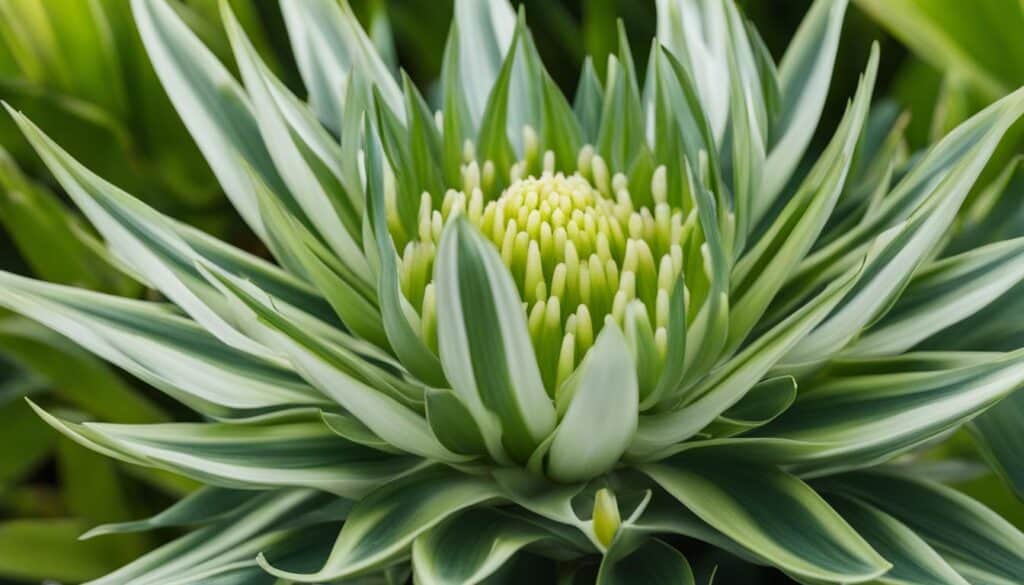
Pineapple Lily as a Cut Flower
The pineapple lily, with its unique and exotic appearance, makes a stunning addition to floral arrangements. The tall flower spikes, reaching up to 2-3 feet in height, create a dramatic display in a vase. The small greenish-white flowers, densely clustered together, resemble pineapples and add a touch of whimsy to any bouquet.
Not only are pineapple lily flowers visually striking, but they also have a long vase life. These flowers can often last up to two weeks when properly cared for. To prolong their longevity, it is important to change the water frequently and trim the stems at an angle every few days. This helps to prevent the build-up of bacteria and keeps the flowers fresh and vibrant.
Pineapple lilies can be paired with a variety of other flowers and foliage to create stunning arrangements. Their unique shape and color make them a versatile choice for both tropical-themed bouquets and mixed floral designs. Whether used as a focal point or as an accent flower, the pineapple lily adds a touch of elegance and intrigue to any arrangement.
“The pineapple lily, with its dense cluster of greenish-white flowers, creates a unique and exotic appeal in floral arrangements. Its long vase life and versatility make it a favorite choice for both professional florists and DIY flower enthusiasts.”
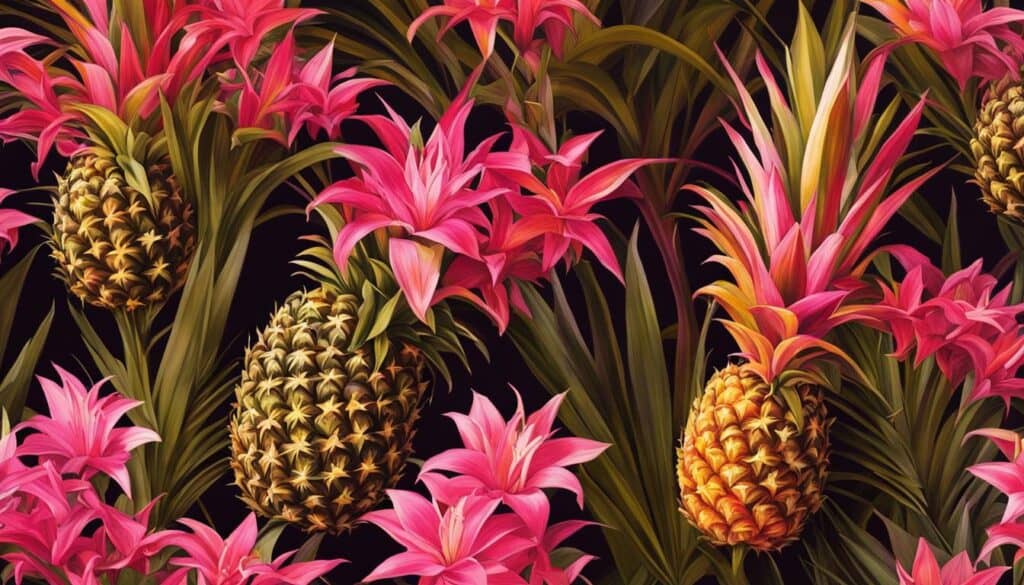
Pineapple Flower Arrangement Ideas
- Create a tropical-themed arrangement using pineapple lilies, orchids, and palm leaves.
- Pair pineapple lilies with vibrant, contrasting flowers like orange roses and purple statice.
- Add texture to an arrangement by including pineapple lilies, eucalyptus, and thistle.
- Combine pineapple lilies with sunflowers and daisies for a cheerful and summery bouquet.
With their unique beauty and long-lasting blooms, pineapple lilies are a fantastic choice for creating eye-catching floral arrangements. Whether for a special occasion, a gift, or simply to brighten up your home, these exotic flowers are sure to make a statement.
Pineapple Lily Symbolism and Decorations
The pineapple lily, with its distinctive and captivating appearance, holds a rich symbolism across various cultures. In Western culture, it is often associated with warmth, hospitality, and abundance. The pineapple’s unique form and sweet taste have made it a traditional symbol of welcome and generosity. This symbolism has been embraced in home decor, where pineapple motifs can be found in wallpapers, tapestries, and architectural accents.
In Asian cultures, the pineapple lily represents wealth, prosperity, and good fortune. Its resemblance to a golden pineapple, combined with its vibrant green foliage, is believed to attract positive energy and financial success. Pineapple lilies are often incorporated into celebrations, such as weddings and New Year festivities, as a way to invite good luck and blessings.
“The pineapple lily embodies the spirit of friendship and hospitality in the Caribbean. Its presence in homes and social gatherings signifies a warm welcome and a joyous atmosphere.”
In the Caribbean, the pineapple lily holds deep cultural significance as a symbol of friendship and a welcoming spirit. Its presence in homes and social gatherings signifies a warm embrace and a joyous atmosphere. Pineapple lilies are often used as centerpieces for tropical-themed parties or as decorative accents for special occasions.
Pineapple Flower Decorations
With its elegant and eye-catching appearance, the pineapple lily is a popular choice for floral decorations. The tall flower spikes, resembling mini pineapples, create a striking centerpiece in bouquets and arrangements. They can be combined with other tropical flowers, such as orchids and bird of paradise, to create a vibrant and exotic display.
Whether used as a standalone centerpiece or incorporated into larger floral designs, pineapple lilies bring a touch of tropical charm to any event or space. Their long-lasting blooms, which can stay fresh for up to two weeks, make them a practical choice for decorations that need to withstand long hours.
Pineapple Flower Centerpiece
A pineapple lily centerpiece can be created by arranging the tall flower spikes in a vase or container. To enhance the visual impact, additional foliage, such as palm leaves or tropical greenery, can be added. The unique shape and colors of the pineapple lilies create a focal point that captures attention and adds a touch of elegance to the table.
Whether used for weddings, parties, or home decor, a pineapple lily centerpiece is sure to impress with its symbolic significance and captivating beauty. It brings a sense of tropical paradise and a warm welcome to any occasion.
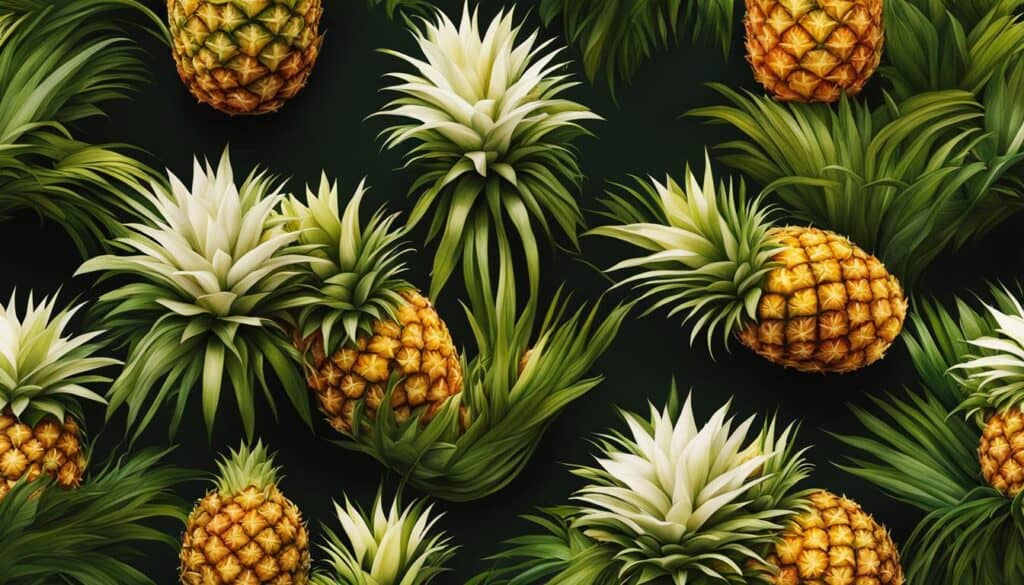
Pineapple Lily’s Journey and History
The pineapple flower, also known as the pineapple lily, has a fascinating journey and rich history that spans several continents. It is believed to have originated in South America, specifically in the region that includes modern-day Paraguay, Brazil, and Argentina. Indigenous people in these areas were the first to cultivate and consume pineapples, recognizing their unique flavor and nutritional value.
European explorers, such as Christopher Columbus, encountered pineapples in the Caribbean islands during their voyages and brought them back to Europe. The fruit quickly gained popularity and became a luxurious delicacy sought after by royalty and the elite. Pineapples were not only prized for their taste, but they also became a symbol of wealth, hospitality, and abundance.
With advancements in horticultural practices and transportation, pineapple cultivation expanded in tropical regions and became a thriving industry. Pineapple plantations were established in places like Hawaii, the Philippines, and Costa Rica, where the climate and soil conditions were ideal for growing this tropical fruit. Today, pineapples are enjoyed worldwide and are a staple in tropical cuisine and refreshing beverages.
“The journey of the pineapple flower reflects the determination and ingenuity of farmers and horticulturists throughout history. From its humble beginnings as a South American plant to its global popularity, the pineapple flower has captivated people with its unique beauty and sweet taste.”
Pineapple Flower Cultivation
Growing pineapple flowers, or pineapple lilies, requires specific conditions to thrive. They prefer well-draining soil and full sun exposure, although they can tolerate partial shade. The bulbs should be planted about 4 inches deep, and the soil should be kept moist until they are established. Once established, pineapple lilies are drought-tolerant and require minimal watering.
Pineapple lilies are not hardy in USDA zone 5 and are typically grown as annuals in cooler climates or overwintered indoors. They can also be grown in containers, which allows for easy mobility and the creation of tropical-themed gardens. Regular fertilization is necessary to promote healthy growth and vibrant blooms.
Overall, the cultivation of pineapple lilies requires minimal effort, making them an excellent choice for both experienced and novice gardeners. Their unique appearance and resilience add a touch of exotic beauty to any garden or floral arrangement.
| Location | Climate | Soil |
|---|---|---|
| Hawaii | Tropical | Volcanic soil |
| Philippines | Tropical | Sandy loam |
| Costa Rica | Tropical | Rich, well-draining soil |
Table: Pineapple Flower Cultivation Locations and Ideal Growing Conditions
Pineapple Growing and Varieties
Growing pineapples can be a rewarding experience, whether you live in a tropical climate or not. With the right techniques and variety selection, you can enjoy homegrown pineapples that are bursting with flavor. There are several popular pineapple varieties to choose from, each with its own unique characteristics and growing requirements.
Smooth Cayenne: This variety is known for its sweet and tangy flavor. It has a golden-yellow flesh and is commonly used for juicing or eaten fresh.
MD-2: Also known as the Gold Extra Sweet, this variety is renowned for its incredibly sweet flavor. It has a vibrant golden color and is often preferred for eating fresh.
Hawaiian Sugarloaf: With its pale yellow flesh and low acidity, this variety is perfect for those who prefer a milder pineapple flavor. It is often used in salads, salsas, or grilled dishes.
Queen: The Queen variety is known for its compact size and intense flavor. It has a rich golden color and is favored for its juiciness. It is commonly used in fruit salads, desserts, or as a topping for pizza and burgers.
| Variety | Flavor | Color | Common Uses |
|---|---|---|---|
| Smooth Cayenne | Sweet and tangy | Golden-yellow | Juicing, eating fresh |
| MD-2 | Incredibly sweet | Golden | Eating fresh |
| Hawaiian Sugarloaf | Mild, low acidity | Pale yellow | Salads, salsas, grilled dishes |
| Queen | Intense | Rich golden | Fruit salads, desserts, toppings |
When growing pineapples, it is important to provide them with well-draining soil and ample sunlight. Pineapples require regular watering, especially during dry periods, but be careful not to overwater as they are susceptible to root rot. Fertilize them every few months with a balanced fertilizer to promote healthy growth and fruit production.
Whether you choose to grow pineapples in your garden or in containers, it’s a rewarding experience that allows you to enjoy the tropical taste of homegrown fruit. With a little patience and care, you’ll soon be savoring the sweetness of your very own pineapples.
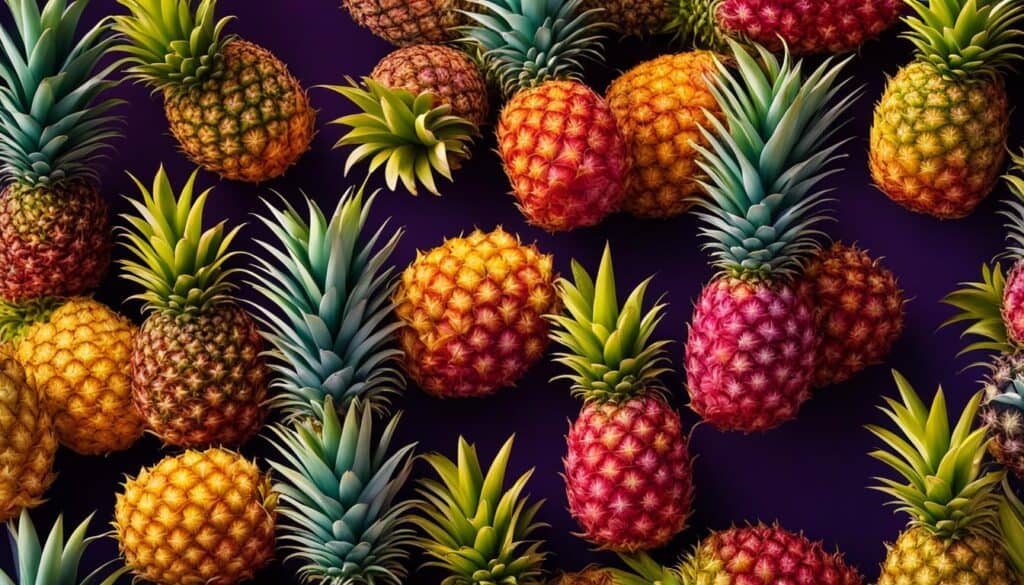
Pineapple Varieties Comparison:
- Smooth Cayenne: Known for its sweet and tangy flavor
- MD-2: Famous for its incredibly sweet taste
- Hawaiian Sugarloaf: Preferred for its mild flavor and low acidity
- Queen: Intense flavor and compact size
Pineapple Flower Symbolism Across Cultures
The pineapple has long been associated with symbolism and cultural significance in various parts of the world. From Western culture to Asian traditions and Caribbean customs, this tropical fruit holds multiple meanings that reflect warmth, hospitality, prosperity, and friendship.
In Western culture, the pineapple is seen as a symbol of warmth, hospitality, and abundance. It represents a welcoming spirit and is often used as a decorative motif in homes and as a centerpiece in gatherings. The pineapple’s unique shape and vibrant appearance make it a visually appealing symbol of generosity and open-heartedness.
In Asian cultures, particularly in China and Southeast Asia, the pineapple symbolizes wealth, prosperity, and good fortune. It is often used as a decorative element during important ceremonies, such as weddings and Chinese New Year celebrations. The golden color and sweet taste of the fruit are believed to bring luck and abundance to those who consume it.
In the Caribbean, the pineapple is a symbol of friendship and hospitality. It represents the warm and welcoming nature of the local communities. Pineapples are often used in traditional Caribbean dishes and as a decorative motif in festivals and celebrations. They are also exchanged as gestures of friendship and goodwill.
“The pineapple is a universal symbol of warmth, hospitality, and friendship. Its rich cultural significance transcends geographical boundaries, connecting people from different parts of the world through its positive and welcoming symbolism.”
Pineapple Flower Symbolism in Hinduism
In Hinduism, the pineapple flower, or Ananas comosus, holds a special meaning. It is associated with purity, enlightenment, and divine energy. The fruit’s crown-like appearance and vibrant color symbolize the majestic presence of deities and the divine cosmic energy that permeates all aspects of life. Pineapples are often offered as sacred offerings during religious rituals and ceremonies.
| Symbolism | Western Culture | Asian Cultures | Caribbean | Hinduism |
|---|---|---|---|---|
| Warmth | ✓ | |||
| Hospitality | ✓ | ✓ | ||
| Abundance | ✓ | |||
| Wealth | ✓ | |||
| Prosperity | ✓ | |||
| Friendship | ✓ | |||
| Divine Energy | ✓ |
The pineapple’s rich symbolism across cultures reflects its inherent beauty and the positive qualities it embodies. Whether it is used as a decorative element, shared as a gesture of friendship, or offered as a sacred offering, the pineapple continues to captivate and inspire people around the world with its cultural significance and universal appeal.

International Pineapple Day: A Global Celebration of the Tropical Treasure
Every year on June 27th, pineapple enthusiasts from around the world come together to celebrate International Pineapple Day. This global celebration is a tribute to the pineapple’s rich history, cultural significance, and delicious taste. Originating in the Caribbean, where pineapples have a long-standing historical significance, International Pineapple Day has now gained popularity worldwide. It is a day filled with festivities that revolve around this tropical treasure.
During International Pineapple Day, pineapple-themed parties take place, where people enjoy tropical drinks, pineapple-inspired treats, and creative pineapple recipe creations. Many individuals also take the opportunity to visit pineapple plantations or gardens, immersing themselves in the world of pineapple cultivation and learning more about the fruit’s journey from farm to table.
International Pineapple Day is not just a celebration of the fruit itself but also a celebration of the cultural significance it holds in various parts of the world. Pineapples symbolize warmth, hospitality, abundance, wealth, prosperity, and good fortune in different cultures. By coming together to celebrate International Pineapple Day, people can embrace these symbolic meanings and appreciate the pineapple’s ability to create connections and bring joy.
So, mark your calendar for June 27th and join pineapple lovers from all corners of the globe in celebrating International Pineapple Day. Whether you’re enjoying a pineapple-infused dish, raising a toast with a pineapple cocktail, or simply admiring the beauty of this tropical fruit, take a moment to savor the uniqueness and global appeal of the pineapple.

The Significance of Pineapples in Different Cultures
“Pineapples have become synonymous with generosity, open-heartedness, and celebration in many parts of the world.”
In Western culture, pineapples represent warmth, hospitality, and abundance. They are often associated with welcoming guests into one’s home, and pineapple motifs can be found in decor and architectural elements with the intention of creating a welcoming atmosphere.
In Asian cultures, pineapples symbolize wealth, prosperity, and good fortune. Pineapple decorations are commonly displayed during festivals and auspicious occasions to attract positive energy and blessings of financial success.
In the Caribbean, pineapples are a symbol of friendship and a welcoming spirit. They are often given as gifts and featured prominently in traditional Caribbean dishes, showcasing the region’s vibrant culinary heritage.
Across different cultures, the pineapple’s significance is intertwined with themes of generosity, celebration, and the creation of meaningful connections. Its universal appeal and positive symbolism make it a beloved fruit that transcends borders and brings people together.
Health Benefits and Culinary Delights of Pineapples
I’m excited to share with you the amazing health benefits and culinary wonders of pineapples. This tropical fruit is not only delicious but also packed with essential nutrients that can boost your well-being.
Pineapples are rich in vitamin C, which is known for its immune-boosting properties. Just one cup of pineapple chunks provides more than the daily recommended intake of vitamin C, helping to strengthen your immune system and protect against common illnesses. Additionally, pineapples contain bromelain, an enzyme that aids in digestion and may reduce inflammation in the body.
| Nutrient | Amount per 1 cup (165g) |
|---|---|
| Vitamin C | 78.9mg |
| Manganese | 1.5mg |
| Fiber | 2.3g |
| Bromelain | 50mg |
Pineapples can also aid in digestion due to their high fiber content. Fiber helps regulate bowel movements, prevent constipation, and promote a healthy gut. Furthermore, the bromelain in pineapples is believed to have anti-inflammatory properties that may help alleviate symptoms of conditions such as arthritis and sinusitis.
Aside from their health benefits, pineapples are incredibly versatile in the culinary world. They can be enjoyed fresh, grilled, juiced, or incorporated into a wide range of dishes. From refreshing tropical smoothies to savory pineapple salsa and even sweet treats like pineapple upside-down cake, there are countless recipes that showcase the tangy-sweet flavor of this tropical fruit.
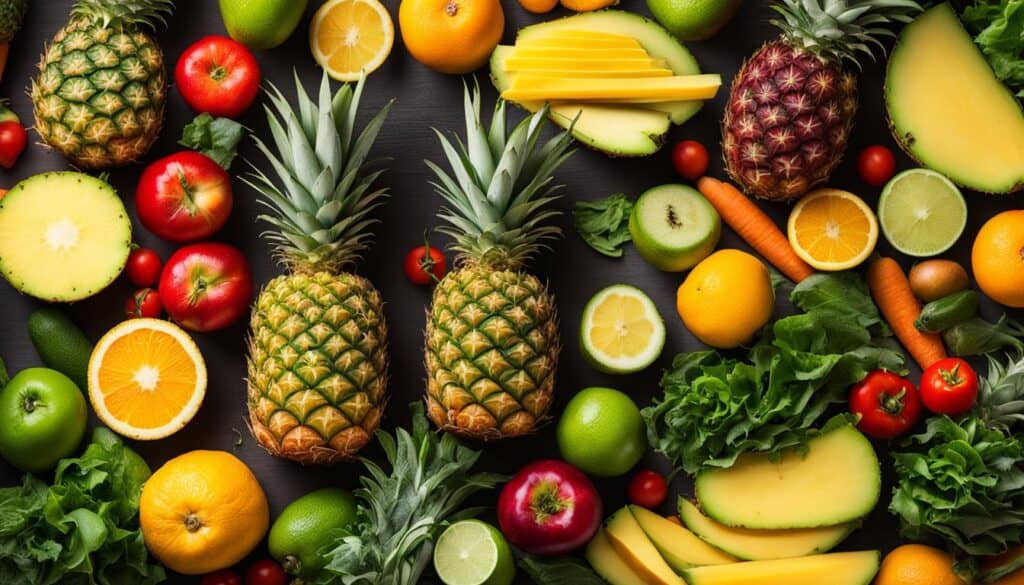
Try these pineapple recipes:
- Pineapple Fried Rice
- Grilled Pineapple and Shrimp Skewers
- Pineapple Chicken Stir-Fry
- Pineapple Upside-Down Cake
Whether you’re looking to boost your health or add a tropical twist to your meals, pineapples are a fantastic choice. So why not incorporate this vibrant fruit into your diet and explore all the health benefits and culinary delights it has to offer?
Growing Pineapples at Home
Growing pineapples at home can be a rewarding and enjoyable experience. With a little patience and the right techniques, you can cultivate your own delicious and tropical fruit right in your backyard. Here are some essential steps to help you get started:
- Choose the right pineapple variety: Selecting the appropriate pineapple variety for your climate and gardening conditions is crucial. Some popular varieties include Smooth Cayenne, MD-2, Hawaiian Sugarloaf, and Queen. Research which variety will thrive best in your region to ensure successful growth.
- Prepare the soil: Pineapples thrive in well-draining soil. Ensure the soil has good drainage by adding organic matter such as compost or well-rotted manure. This will help retain moisture without causing waterlogged roots.
- Planting: Plant the pineapple crown (the leafy top) in the prepared soil. Make sure the crown is planted at a depth where the base is just above the soil level. Avoid burying the crown too deep, as it can lead to rotting.
- Watering: Pineapples require regular watering to establish strong root systems. Water deeply but infrequently, allowing the soil to dry out slightly between waterings. Avoid overwatering, as this can lead to root rot.
- Provide ample sunlight: Pineapples thrive in full sun, so ensure they receive at least six to eight hours of direct sunlight each day. Place them in a sunny spot in your garden or consider growing them in containers that can be moved to capture the sun’s rays.
- Fertilization: Pineapples benefit from regular fertilization. Use a balanced, slow-release fertilizer formulated for fruiting plants. Apply it according to the package instructions, being careful not to over-fertilize as this can damage the plant.
- Protect from pests and diseases: Keep an eye out for common pests such as mealybugs and scale insects. If you notice any signs of infestation, treat the plant with an appropriate organic insecticide. Additionally, ensure good air circulation around the plant to prevent fungal diseases.
- Be patient: Growing pineapples can be a slow process. It typically takes about 18-24 months for a pineapple plant to produce fruit. During this time, provide consistent care and be patient. The wait will be worth it when you taste the sweet, homegrown pineapple!
By following these steps and providing the right conditions, you can enjoy the satisfaction of growing your own delicious pineapples at home. With their tropical flavor and unique beauty, homegrown pineapples are sure to impress your family and friends.
Table: Essential Care Guide for Growing Pineapples at Home
| Step | Description |
|---|---|
| Choose the right pineapple variety | Select a variety suited for your climate and gardening conditions. |
| Prepare the soil | Ensure well-draining soil with the addition of organic matter. |
| Planting | Plant the pineapple crown at the appropriate depth. |
| Watering | Water deeply but infrequently, allowing for slight drying between waterings. |
| Provide ample sunlight | Place the pineapple in a sunny spot with at least 6-8 hours of direct sunlight. |
| Fertilization | Apply a balanced, slow-release fertilizer according to package instructions. |
| Protect from pests and diseases | Treat pests with organic insecticides and ensure good air circulation. |
| Be patient | It takes about 18-24 months for a pineapple plant to produce fruit. |
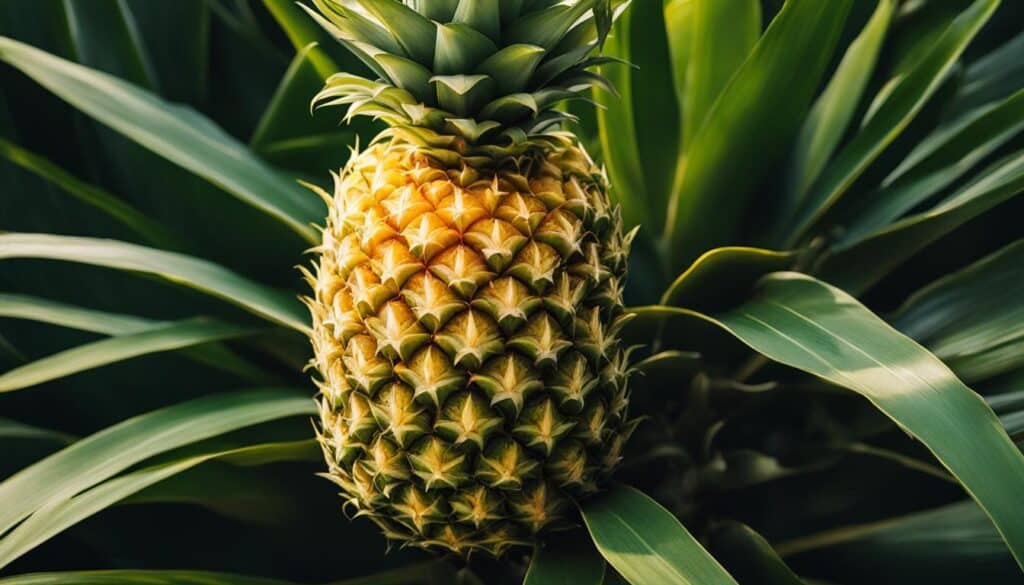
Conclusion
The pineapple flower, also known as the pineapple lily, is a captivating plant that adds a touch of tropical beauty to any garden. With its striking inflorescence and vibrant foliage, it is sure to catch the attention of both novice and experienced gardeners alike. Whether used as a cut flower, as a symbol of hospitality, or grown at home, the pineapple flower never fails to impress.
From its origins in South America to its flourishing cultivation in tropical regions worldwide, the pineapple flower’s journey is a testament to the determination and ingenuity of farmers and horticulturists. This incredible plant has not only gained popularity for its aesthetic appeal but also for its cultural significance in various parts of the world.
So, whether you choose to incorporate pineapple flowers into your garden, use them in stunning floral arrangements, or enjoy the sweetness of homegrown pineapples, embracing the allure of the pineapple flower is a delightful experience. Its unique beauty and rich history make it a true treasure in the world of plants.
FAQ
Q: Can pineapple lilies be grown in containers?
A: Yes, pineapple lilies can be grown in containers and used to create tropical-themed gardens or as a focal point in mixed borders.
Q: What type of soil do pineapple lilies require?
A: Pineapple lilies require well-draining soil.
Q: Do pineapple lilies need full sun?
A: Yes, pineapple lilies require full sun, but they can tolerate partial shade.
Q: Are pineapple lilies drought-tolerant?
A: Yes, pineapple lilies are drought-tolerant and low maintenance.
Q: How deep should pineapple lily bulbs be planted?
A: Pineapple lily bulbs should be planted about 4 inches deep.
Q: How often should pineapple lilies be watered?
A: Once established, pineapple lilies require little watering and can be left to grow on their own.
Q: Are pineapple lilies hardy in USDA zone 5?
A: No, pineapple lilies are not hardy in USDA zone 5 and are typically grown as annuals or overwintered indoors in cooler climates.
Q: How long do pineapple lily flowers last in a vase?
A: Pineapple lily flowers can last for up to two weeks in a vase.
Q: What do pineapple lilies symbolize?
A: In Western culture, pineapple lilies symbolize warmth, hospitality, and abundance.
Q: How long does it take for a pineapple plant to produce fruit?
A: It takes about 18-24 months for a pineapple plant to produce fruit.
Q: What are the health benefits of pineapples?
A: Pineapples are high in vitamin C, manganese, and bromelain, which can boost the immune system, promote healthy digestion, reduce inflammation, aid in wound healing, and alleviate certain respiratory conditions.
Source Links
- https://countryhomeandblooms.com/pineapple-lilies-touch-of-the-tropics-with-eucomis/?utm_source=rss&utm_medium=rss&utm_campaign=pineapple-lilies-touch-of-the-tropics-with-eucomis
- https://www.uaex.uada.edu/yard-garden/resource-library/plant-week/pineapple.aspx
- https://thursd.com/articles/international-pineapple-day

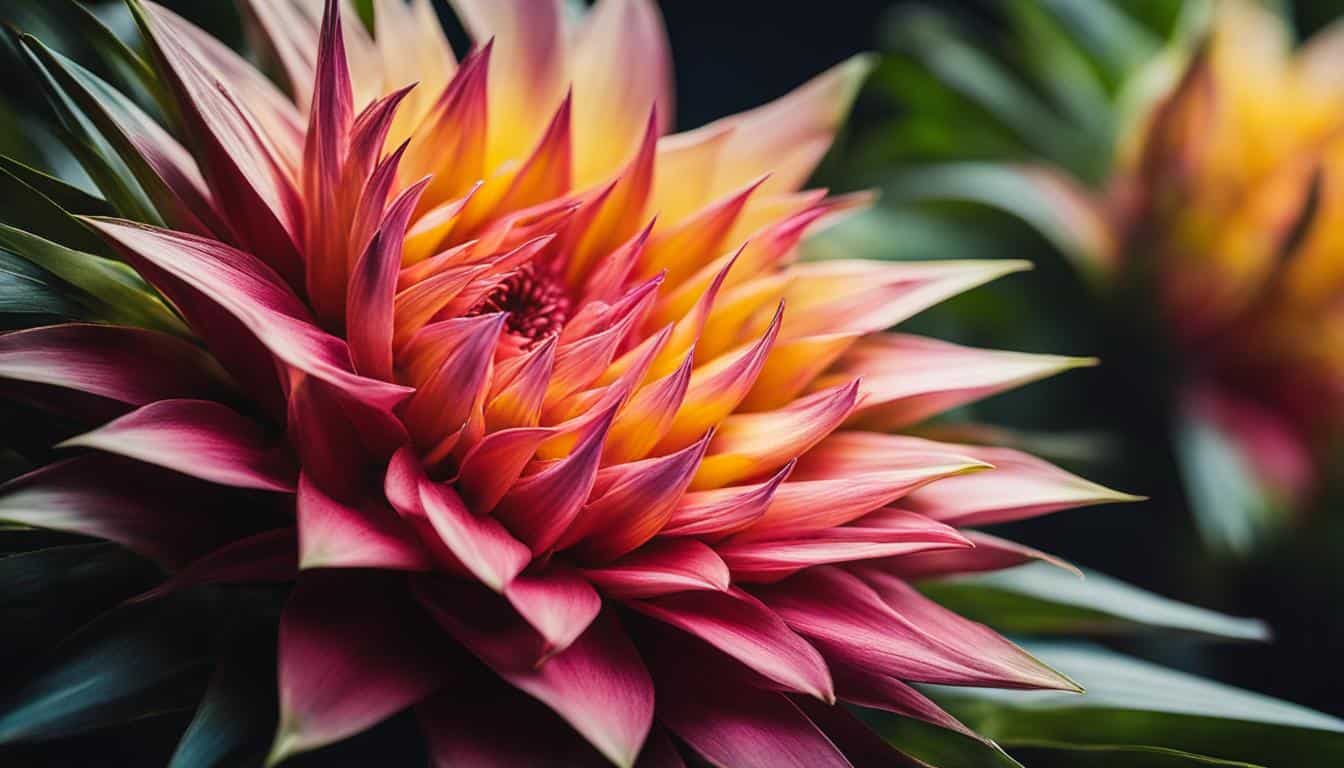



Leave a Reply